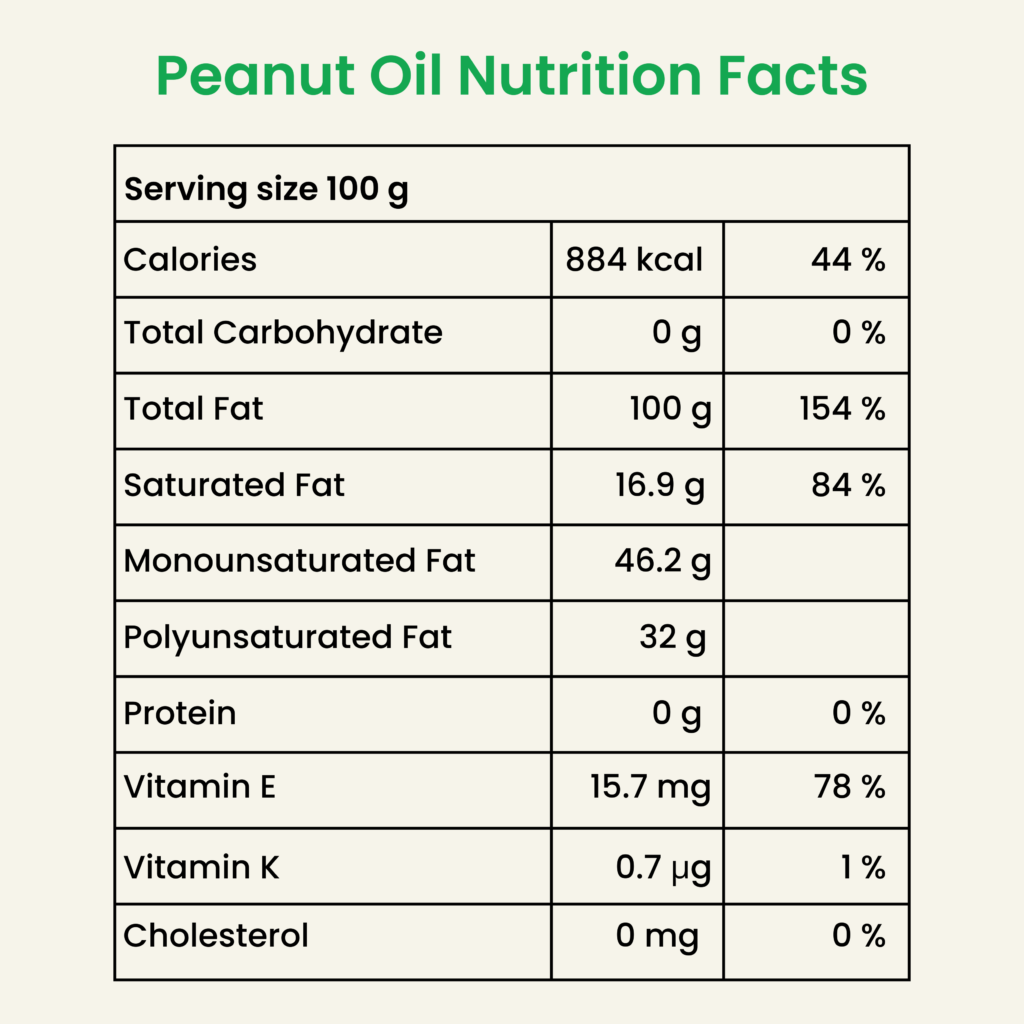There is no item in your cart
Groundnut oil, also called peanut oil or arachis oil, is a versatile cooking oil made from groundnut seeds. These plants grow well in warm climates, which is why India produces and consumes a lot of this oil.
There are four main types of groundnut oil: double filtered groundnut oil, refined, cold-pressed, and roasted. Double filtered groundnut oil is a purified peanut oil that undergoes two filtration stages to remove impurities, enhancing its quality, shelf life, and flavor for versatile cooking uses. Refined oil goes through a strict cleaning process to remove impurities and allergens. Cold-pressed oil keeps more nutrients but needs careful filtering to be safe. Roasted groundnut oil is mostly used for its special taste in food, not for cooking.
Groundnut oil has a mild flavor that fits well in many dishes, from traditional Indian cuisine to exotic dishes from Southeast Asia.
Origin of groundnut oil
While groundnut oil is now a global commodity, its journey began in the heart of South America. The peanut, the source of groundnut oil, is believed to have originated in the tropical regions of Brazil and Peru. These ancient civilizations were the first to cultivate and consume this legume.
Archaeological evidence suggests that peanuts have been cultivated for thousands of years. Over time, the cultivation of peanuts spread to other parts of the Americas and eventually to Africa, Asia, and other regions with suitable climates. With the increasing popularity of the peanut, the extraction of its oil for culinary and other purposes became a common practice.
Today, groundnut oil is produced in various countries around the world, with India and China being major producers. However, the roots of this versatile oil can be traced back to the fertile lands of South America.
Nutritional values and general properties of groundnut oil
Groundnut oil is not just a flavor enhancer; it’s a nutritional powerhouse. It is primarily composed of healthy fats, making it a valuable addition to a balanced diet.
Fatty acid profile
- Monounsaturated fats (MUFAs): Groundnut oil is rich in oleic acid, a heart-healthy monounsaturated fat. MUFAs help reduce bad cholesterol levels while increasing good cholesterol.
- Polyunsaturated fats (PUFAs): It contains linoleic acid, an omega-6 fatty acid essential for various bodily functions.
- Saturated Fats: While present, the levels of saturated fats in groundnut oil are relatively low compared to other oils.
Vitamins and minerals
- Vitamin E: A potent antioxidant that protects cells from damage.
- Other nutrients: While not a significant source of other vitamins and minerals, groundnut oil does contribute to overall nutrient intake.
General Properties
- High Smoke Point: Groundnut oil has a high smoke point, making it suitable for high-temperature cooking methods like frying and sautéing.
- Neutral Flavor: Its mild taste allows the flavors of the food to shine through.
- Stability: Groundnut oil is relatively stable, meaning it resists rancidity well.
It’s important to note that while groundnut oil offers several health benefits, moderation is key. It should be consumed as part of a balanced diet.

Groundnut oil for cooking: A culinary gem
Groundnut oil is a versatile cooking oil celebrated for its high smoke point, neutral flavor, and nutritional benefits. Its ability to withstand high temperatures without breaking down makes it an excellent choice for various cooking methods.
Ideal for high-heat cooking
- Deep-frying: Groundnut oil produces crispy exteriors and tender interiors in fried foods. Its neutral flavor doesn’t overpower the taste of the food.
- Sautéing and Stir-frying: The high smoke point allows for quick and efficient cooking while preserving the flavors of your ingredients.
- Roasting: Whether it’s roasting vegetables or poultry, groundnut oil adds a subtle nutty flavor without overpowering the dish.
Beyond frying
While groundnut oil excels in high-heat cooking, its uses extend beyond the stovetop:
- Baking: Use it as a substitute for butter or other oils in certain recipes for a lighter texture and nutty flavor.
- Salad dressings: Create flavorful dressings with a hint of nuttiness by combining groundnut oil with vinegar, herbs, and spices.
- Marinades: Infuse meats and vegetables with the subtle taste of groundnut oil for a delicious marinade.
Remember
- Cold-pressed groundnut oil retains more nutrients but might have a stronger flavor.
- Refined groundnut oil has a neutral taste and is more suitable for high-temperature cooking.
- Store groundnut oil in a cool, dark place to maintain its quality.
By incorporating groundnut oil into your cooking, you’re not only enhancing the flavor of your dishes but also reaping the benefits of its healthy fat content.
Health benefits of groundnut oil
Groundnut oil is more than just a cooking medium; it offers several potential health benefits due to its rich nutrient profile.
- Heart health: The high content of monounsaturated fats, particularly oleic acid, helps reduce bad cholesterol levels while increasing good cholesterol. This can contribute to a healthier heart.
- Antioxidant power: Groundnut oil contains vitamin E, a potent antioxidant that protects cells from damage caused by harmful free radicals.
- Potential for blood sugar control: Some studies suggest that groundnut oil might help regulate blood sugar levels, making it beneficial for individuals with diabetes. However, more research is needed to confirm this.
- Skin health: The vitamin E in groundnut oil can help nourish and protect the skin from oxidative stress.
It’s important to note that while groundnut oil offers potential health benefits, it should be consumed as part of a balanced diet. Moderation is key.
Groundnut oil and weight loss
While groundnut oil itself doesn’t directly burn fat, it can play a role in weight management. The key lies in its composition.
- Appetite control: Groundnut oil contains oleic acid, a monounsaturated fat linked to appetite suppression. By helping to control hunger, it can indirectly support weight loss efforts.
- Calorie consciousness: Remember, all oils, including groundnut oil, are high in calories. Consuming excess amounts can hinder weight loss. The trick is to use it in moderation and as a replacement for less healthy oils.
- Part of a balanced diet: Groundnut oil is best utilized as part of a comprehensive weight loss plan that includes a calorie deficit, regular exercise, and a focus on whole foods.
Popular dishes and versatile uses of groundnut oil in cooking
- Samosas
- Pakodas
- Oats Roti
- Chana dal pancakes
- Poha
- Vegetable Pulao
Conclusion
Groundnut oil stands out as a versatile and healthy choice for cooking, deeply rooted in India’s culinary traditions. Its high smoke point, neutral flavor, and nutritional benefits make it ideal for a variety of cooking methods, from deep-frying crispy snacks like samosas and pakodas to enhancing the flavors of everyday dishes. With the robust flavor of double filtered groundnut oil from Green Selects, incorporating groundnut oil into your cooking not only elevates taste but also contributes to a balanced diet. Explore the culinary possibilities and nutritional benefits of groundnut oil today, available in convenient options that suit every kitchen need.
FAQs
1. Is groundnut oil good for weight loss?
While groundnut oil itself doesn’t burn fat, it can aid in weight management by helping control appetite due to its oleic acid content. However, moderation is key.
2. Can I use groundnut oil for baking?
Yes, groundnut oil can be used for baking. It can provide a lighter texture and subtle nutty flavor to your baked goods.
3. What is the difference between refined and double-filtered groundnut oil?
- Refined groundnut oil undergoes a chemical process to remove impurities, resulting in a neutral taste and higher smoke point, making it suitable for high-temperature cooking.
- Double-filtered groundnut oil is processed through a physical filtration process to remove impurities, retaining more of the oil’s natural flavor and nutrients. It might have a slightly lower smoke point compared to refined oil.

